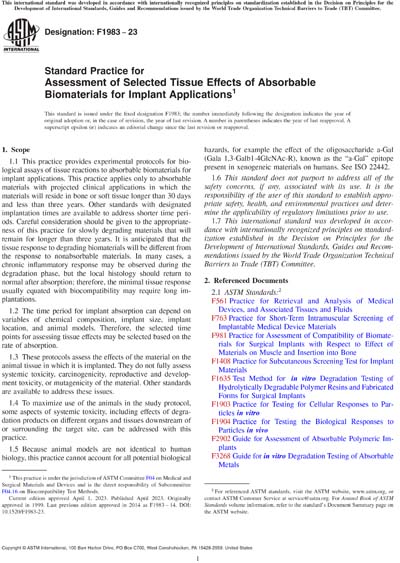Most recent
ASTM F1983-23
Standard Practice for Assessment of Selected Tissue Effects of Absorbable Biomaterials for Implant Applications
1.1This practice provides experimental protocols for biological assays of tissue reactions to absorbable biomaterials for implant applications. This practice applies only to absorbable materials with projected clinical applications in which the materials will reside in bone or soft tissue longer than 30 days and less than three years. Other standards with designated implantation times are available to address shorter time periods. Careful consideration should be given to the appropriateness of this practice for slowly degrading materials that will remain for longer than three years. It is anticipated that the tissue response to degrading biomaterials will be different from the response to nonabsorbable materials. In many cases, a chronic inflammatory response may be observed during the degradation phase, but the local histology should return to normal after absorption; therefore, the minimal tissue response usually equated with biocompatibility may require long implantations.
1.2The time period for implant absorption can depend on variables of chemical composition, implant size, implant location, and animal models. Therefore, the selected time points for assessing tissue effects may be selected based on the rate of absorption.
1.3These protocols assess the effects of the material on the animal tissue in which it is implanted. They do not fully assess systemic toxicity, carcinogenicity, reproductive and development toxicity, or mutagenicity of the material. Other standards are available to address these issues.
1.4To maximize use of the animals in the study protocol, some aspects of systemic toxicity, including effects of degradation products on different organs and tissues downstream of or surrounding the target site, can be addressed with this practice.
1.5Because animal models are not identical to human biology, this practice cannot account for all potential biological hazards, for example the effect of the oligosaccharide a-Gal (Gala 1,3-Galb1-4GlcNAc-R), known as the "a-Gal" epitope present in xenogeneic materials on humans. See ISO 22442.
1.6This standard does not purport to address all of the safety concerns, if any, associated with its use. It is the responsibility of the user of this standard to establish appropriate safety, health, and environmental practices and determine the applicability of regulatory limitations prior to use.
1.7This international standard was developed in accordance with internationally recognized principles on standardization established in the Decision on Principles for the Development of International Standards, Guides and Recommendations issued by the World Trade Organization Technical Barriers to Trade (TBT) Committee.
Content Provider
ASTM International [astm]






